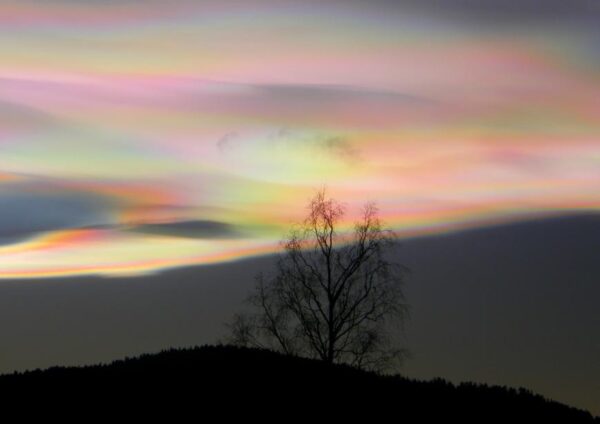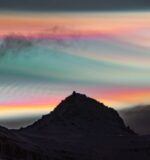Rare clouds that give off bright, multi-colored light like an aurora were recently spotted at multiple locations in the Arctic. But what causes them?

(opens in new tab)
The dark skies in the Arctic Circle recently shone with ethereal multi-colored light. But this jaw-dropping spectacle was not caused by auroras. Instead, the iridescent rainbows were caused by clouds of tiny ice crystals floating higher in the atmosphere than is normally possible.
The clouds, known as polar stratospheric clouds (PSC), only form when the lower stratosphere reaches temperatures below minus 114 degrees Fahrenheit (minus 81 degrees Celsius). Normally, clouds do not form in the stratosphere because it is too dry, but at these extremely low temperatures “widely-spaced water molecules begin to coalesce into tiny ice crystals” that form into clouds, Spaceweather.com(opens in new tab) reported. This means PSCs can form much higher up than normal clouds, between 9.3 and 15.5 miles (15 to 25 kilometers) above the ground.

There are two types of PSCs: Type I, which are made from a mix of ice crystals and nitric acid, which produces less spectacular colors and may be linked to the formation of ozone holes; and Type II, which are composed of pure ice crystals and produce more vivid colors. The ones that recently formed over the Arctic were Type II.
Type II PSCs are often referred to as nacreous clouds because their iridescent hues can sometimes resemble nacre, also known as mother of pearl, which is produced in the shells of some mollusks. However, they are much rarer than Type I clouds.
Type II clouds typically occur no more than two or three times a year in the Arctic, normally during the colder winter months, according to Spacewaether.com. However, experts believe that both types of PSCs could occur more often in the future as climate change creates more extreme weather, which could have a knock-on impact on the ozone layer if more Type I clouds can form, according to NASA(opens in new tab).
Due to their intense colors, nacreous clouds are often confused with the northern lights, or aurora borealis, in the Arctic. These more common phenomena occur when highly energetic particles emitted by the sun travel down the magnetic field lines of Earth’s magnetosphere.







 Photographer Finds Locations Of 1960s Postcards To See How They Look Today, And The Difference Is Unbelievable
Photographer Finds Locations Of 1960s Postcards To See How They Look Today, And The Difference Is Unbelievable  Hij zet 3 IKEA kastjes tegen elkaar aan en maakt dit voor zijn vrouw…Wat een gaaf resultaat!!
Hij zet 3 IKEA kastjes tegen elkaar aan en maakt dit voor zijn vrouw…Wat een gaaf resultaat!!  Scientists Discover 512-Year-Old Shark, Which Would Be The Oldest Living Vertebrate On The Planet
Scientists Discover 512-Year-Old Shark, Which Would Be The Oldest Living Vertebrate On The Planet  Hus til salg er kun 22 kvadratmeter – men vent til du ser det indvendigt
Hus til salg er kun 22 kvadratmeter – men vent til du ser det indvendigt  Nearly Frozen Waves Captured On Camera By Nantucket Photographer
Nearly Frozen Waves Captured On Camera By Nantucket Photographer  Superknepet – så blir snuskiga ugnsformen som ny igen!
Superknepet – så blir snuskiga ugnsformen som ny igen!  It’s Official: Astronomers Have Discovered another Earth
It’s Official: Astronomers Have Discovered another Earth  Meteorite That Recently Fell in Somalia Turns Out to Contain Two Minerals Never Before Seen on Earth
Meteorite That Recently Fell in Somalia Turns Out to Contain Two Minerals Never Before Seen on Earth 
hc5zc5
uo82wv
mxss02
vu0c3j